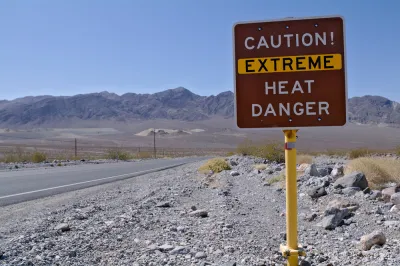A new UCLA study examines how formal and informal cooling centers are being used in Los Angeles County.

As climate change makes heat waves longer and more severe, people turn to both formal and informal cooling centers for relief in Los Angeles County. Formal cooling centers are typically offered at libraries, parks, and other public facilities. Informal ones are places like shopping centers, coffee shops, and other indoor spaces with AC. As reported in this article by David Colgan, a new UCLA study published online in the journal Applied Geography uses smartphone data to examine for the first time how formal and informal cooling centers are being used in L.A. County.
The study reveals that:
- About 20 percent of the population uses cooling centers in the county.
- The vast majority of those who visit cooling centers use shopping malls and other informal cooling centers; far fewer visit official cooling centers.
- When temperatures reach or exceed 95 degrees, the cooling centers that see the greatest increase in visits are those located near public transit stops.
- For people without automobiles, the elderly and other disadvantaged groups, official cooling centers may be the only practical option.
To reach their findings, the researchers used smartphone data that was anonymized and aggregated, which eliminates the possibility of revealing any specific locations for a particular smartphone. The data were acquired from Outlogic, a private location data provider that collects data on consenting users of third-party mobile phone applications.
The study offers several recommendations for decision and policy-makers, including placing more cooling centers in underserved neighborhoods where residents are more reliant on them, placing centers close to transit stops, and making cooling centers a part of more comprehensive strategies to mitigate extreme heat exposure.
For more information, please read the source article.
FULL STORY: Beating the heat in L.A.: County’s ‘informal’ cooling centers are used more than official ones

Analysis: Cybertruck Fatality Rate Far Exceeds That of Ford Pinto
The Tesla Cybertruck was recalled seven times last year.

National Parks Layoffs Will Cause Communities to Lose Billions
Thousands of essential park workers were laid off this week, just before the busy spring break season.

Retro-silient?: America’s First “Eco-burb,” The Woodlands Turns 50
A master-planned community north of Houston offers lessons on green infrastructure and resilient design, but falls short of its founder’s lofty affordability and walkability goals.

Test News Post 1
This is a summary

Analysis: Cybertruck Fatality Rate Far Exceeds That of Ford Pinto
The Tesla Cybertruck was recalled seven times last year.

Test News Headline 46
Test for the image on the front page.
Urban Design for Planners 1: Software Tools
This six-course series explores essential urban design concepts using open source software and equips planners with the tools they need to participate fully in the urban design process.
Planning for Universal Design
Learn the tools for implementing Universal Design in planning regulations.
EMC Planning Group, Inc.
Planetizen
Planetizen
Mpact (formerly Rail~Volution)
Great Falls Development Authority, Inc.
HUDs Office of Policy Development and Research
NYU Wagner Graduate School of Public Service




























